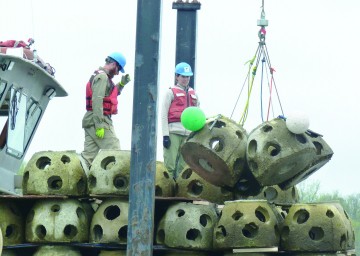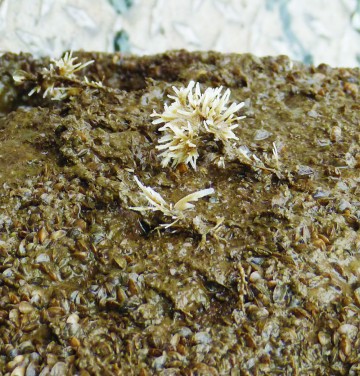Science on the Bay
A fiction writer imagining a character destined to become a key figure in Bay oyster restoration could save much time by basing the depiction on real-life Allison Colden, a fisheries scientist with the Chesapeake Bay Foundation.
From an early age, Colden seemed destined for a role in Bay restoration. Growing up in Virginia Beach, she gravitated to the Virginia Aquarium and Marine Science Center, learning about the Bay and the problems it is facing. She did her undergraduate work at the University of Virginia, majoring in biology while doing field work on Virginia’s Eastern Shore. For her PhD at the Virginia Institute of Marine Science (part of William and Mary), she researched how to construct oyster reefs for maximum production. Next, foreshadowing the political aspect of Bay restoration, she spent a year on Capitol Hill as a NOAA fellow for a California congressman, advising on fisheries and natural resources policy. Then, in January of 2017, after a year with a Virginia nonprofit estuary restoration group, she joined the Chesapeake Bay Foundation as a Maryland fisheries scientist specializing in oysters.
She does some work on other fisheries — notably crabs and striped bass — but most of her time goes to our favorite bivalve.
“I’ve been fixated on oysters for a long time,” she told me as the 60-foot Foundation workboat Patricia Campbell, moved up the Severn River to begin an oyster restoration experiment.
“Every research paper I worked on in college turned out to be about oysters. By the time I entered grad school I knew I wanted to work on bringing this important species back.”
Joining Chesapeake Bay Foundation gave her opportunity for hands-on science. “As much as I respect and admire my academic colleagues, I realized it took more than publishing papers to effect change,” she said.
Now an Annapolitan, she’s never far from the Bay.
“Every day my husband and I take our Australian terrier Bismarck on a walk along Back Creek,” she said. “Being able to work for positive change is important to me as a citizen of the Chesapeake Bay watershed.”
Hands-on in the Field
In April 2018, the Patricia Campbell was underway to drop concrete reef balls into the Severn River to test one of Colden’s oyster-directed hypotheses: Could “man-made oyster reefs with vertical structure agitate currents and break up dead zones?”
It’s long been known that weather can affect dead zones; turbulent weather stirs up the water column, distributing oxygen-rich waters throughout. Could added structures do the stirring?
The hope was this stirring would mix the oxygen-rich water on the surface with the oxygen-depleted water on the bottom, thus lessening the dreaded dead zones that plague our waterways every summer.
These vertical structures were concrete half-balls about two feet across. The ship’s crane easily lifted the 240-pound balls and precisely placed them about a mile up from the Route 50 bridge in an area known as the Winchester Lump.
This experiment was about water stirring, but reef balls make good oyster habitat, too. So why not try to grow more oysters at the same time? The balls were preloaded at the Foundation Oyster Restoration Center in Shady Side with almost a million oyster spat. An instrument pod to measure certain key water parameters, like stirring, was also lowered to the bottom. The pod was to be retrieved in a few weeks. In the fall, Colden and the team of scientists would return to the new reef to check on the progress of the oyster spat.
Murphy’s Law
Anything that can go wrong, will go wrong. Who hasn’t experienced it?

In the biological and environmental sciences, Murphy’s Law can call on the forces of nature to humble up even the best-planned experiment. In this case, it was the record-breaking rain. All that fresh water pouring down lowers the salt content of Bay water. Fish can swim to areas of higher salinity. Oysters don’t have that luxury; they can be stunted or die if the water isn’t salty enough.
The deluges also had other effects. Freshwater sitting on top of saltier water creates a boundary that discourages mixing of the water column, exacerbating dead zones. There was also a significant algae bloom, a mahogany tide, in the river this summer. Such blooms cause dead zones.
The reef ball instruments recorded a four percent increase in mixing of the water column due to the reef balls. Still, the effect on the biology of the river was less clear; Colden suspected the algae and the fresh water would greatly affect the ecosystem of the river.
To get the final word on that, she would have to wait for the return trip to the reef balls.
Return to Winchester Lump
The April trip to place the reef balls had been a pleasant day on the water; the trip in late November to check the progress of the oysters was anything but. After several delays due to gale warnings and rain, the day of the trip was cold and cloudy. The only person who seemed properly dressed for the weather was the dry-suit-clad diver who would attach lines and floats to the submerged reef balls so they could be hauled up and examined.
The balls emerged from their seven-month soak yielding expected but still disappointing news. There was plenty of life on the balls, but no oysters; rain and algae had done them in.

All was not lost, however. The concrete was covered with false mussels. These are also filter feeders, which contribute to water quality, but they tend to be transient. Also present were worms and hydroids, a colonial animal like coral. We even found a naked goby fish.
“We showed the reef balls can increase water column mixing and can decrease dead zones,” Colden explained in our followup interview. “We also learned that water depth matters, and in the future we might want to try the technique with a shallower bottom. We also learned that even with a low-oxygen, low-salinity environment, we can have life. It’s just different life.”
